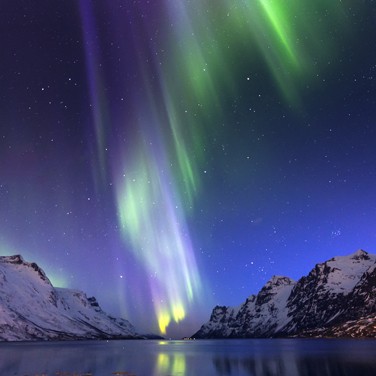The Northern Lights: A Natural Show
by Mike Howie
In the northernmost and southernmost reaches of our planet, there are light shows unlike any other, creating rings around the poles.
The Aurora Borealis, or northern lights, and Aurora Australis, the southern counterpart, dance across the sky in beautiful shades and combinations of colors. To the people of medieval times, the lights were seen as harbingers of war and famine. People around the world, including the Maori tribe of New Zealand, thought the lights were reflections of torches or campfires. While the auroras may seem otherworldly or look like a piece of art, their cause is a work of science.
A Trip from the Sun
The light displays actually begin with the sun, where gas molecules in its outer (corona) layer are heated to millions of degrees Celsius. The molecules collide and explode, releasing protons and electrons that form a gaseous flow known as the “solar wind,” which is pushed out into space by the rotation of the Sun.
When the solar winds come into contact with the Earth’s magnetic forces (the magnetosphere), most of the charged particles are deflected. However, some of these particles enter our atmosphere at the poles, where the magnetic field is weaker. There, the particles excite and ionize particles in our atmosphere, which release energy that produces the fascinating lights of the auroras. These lights can extend from 50 to 400 miles above the Earth’s surface.
Colorful Collisions
The visible colors depend on the elements in the gases that are excited and then release light at specific wavelengths. At 60 miles above the Earth, oxygen molecules produce a pale yellow-green, the most common color. Oxygen molecules at 200 miles above the Earth emit at a different wavelength that can produce rare all-red auroras. At lower altitudes, molecular and ionized nitrogen produces mostly blue, along with red and purple.
The lights may take on different shapes throughout the course of a night. In the earlier evening hours, they may appear to be made of tall rays that look like window curtains and can form arcs that stretch across the sky. Around midnight, the arcs may look like they are moving as if blown by a wind and are known to fill the whole sky in a bright and active auroral substorm. In the morning, the lights become patchy and cloud-like, blinking on and off for hours before fading away with the rising sun.
Where to See the Show
On most clear nights, the northern lights are visible from the auroral zone, a horizontal band centered at a latitude around 66 degrees north. However, solar storms called coronal mass ejections (CME) can enhance the lights and make them visible over wider areas. In 2016, a CME produced an Aurora Borealis that could be seen as far south as Illinois and Ohio.
For many people in North America, seeing the aurora firsthand means taking a trip farther north. The far eastern portions of Canada tend to be too cloudy, but one can find a clear view from the auroral zone between James Bay and the west coast of Canada.
In Europe, the northern parts of Scandinavia are ideal. For example, Tromso, Norway features beautiful scenery and guided tours in addition to the lights. And Abisko National Park in Sweden, which receives less precipitation than any other area in the auroral zone, is quickly becoming the world’s most popular aurorawatching destination. A view from Russia will be harder to find: while much of the auroral zone is in the northern part of the country, it’s a difficult area to reach and lacks a tourism infrastructure.
Those hoping to catch a view of the Aurora Australis also have limited options. Most of the southern auroral zone lies over Antarctica, although one can sometimes see the lights from New Zealand or Tasmania.
When to Watch
The months between December and April are the best time to get a glimpse of the northern show — the summer months don’t provide enough darkness, and fall months tend to be cloudy. While active periods can happen anytime during the dark hours, they’re particularly likely between 10 p.m. and 2 a.m. local time and last for about 30 minutes.
The northern lights are a beautiful natural phenomenon. And for those who seek or stumble across them, they’re unforgettable.
